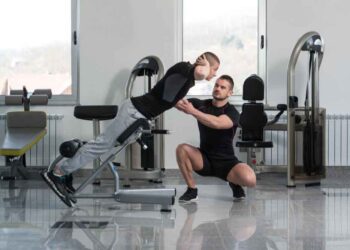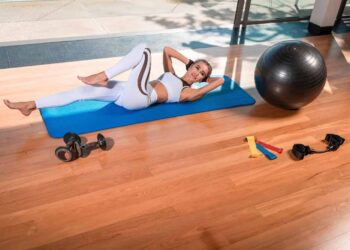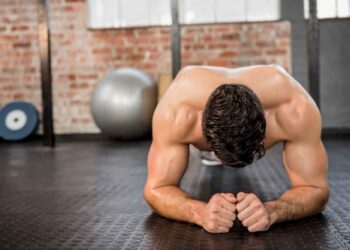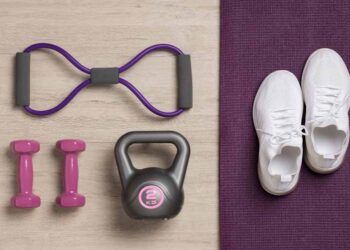Are you looking to add a new exercise to your fitness routine that targets multiple muscle groups and improves core strength? Look no further than the good morning exercise! This often misunderstood and underutilized movement is a must-try for anyone wanting to strengthen their posterior chain and enhance overall muscular development.
But what exactly is a good morning exercise? How do you perform it with proper form and technique? And what are the benefits of incorporating it into your workout routine? Let’s dive in and find out!
Key Takeaways:
- Good mornings are a weight lifting movement that targets the posterior chain and improves core strength.
- They involve a posteriorly top loaded hip hinge and work the musculature of the entire body.
- Proper form and technique are essential for performing good mornings safely and effectively.
- Benefits of good mornings include total body strength, improved power development, and better movement mechanics.
- Start with lighter weights and gradually increase the load as strength and form improve.
What is a Good Morning?
A good morning is a posteriorly top loaded hip hinge movement that is commonly used in the world of weightlifting. Similar to a barbell hip thrust or kettlebell swing, this exercise involves extending the hips backward with the glutes flaring while maintaining a reinforced neutral spine position. It is essential to note that the entire length of the body acts as a lever arm during this movement, working the musculature of the erector spinae, deep core muscles, glutes, and hamstrings.
Good mornings are an effective way to target the posterior chain, which refers to the muscles on the backside of the body. This includes the glutes, hamstrings, and lower back. By properly executing this exercise, you can engage and strengthen these muscle groups, improving both functionality and overall strength.
During a good morning exercise, the load is typically placed on the upper back rather than in the hands or on the front of the body. This top-loaded position creates a unique challenge that requires proper form and technique to ensure the load is distributed throughout the posterior chain.
Proper execution of the good morning exercise involves:
- Standing with feet hip-width apart, toes pointing forward.
- Engaging the core and maintaining a neutral spine position.
- Initiating the movement by hinging at the hips and sending them backward.
- Ensuring the glutes flare and the spine remains neutral throughout the movement.
It is important to note that good mornings are demanding exercises that require proper coaching and instruction. It is recommended to start with lighter weights and gradually increase the load as strength and form improve to ensure safety and efficacy.
Muscles Targeted in Good Mornings
| Muscle Group | Primary Muscle | Secondary Muscles |
|---|---|---|
| Erector Spinae | ✓ | ✓ |
| Glutes | ✓ | ✓ |
| Hamstrings | ✓ | ✓ |
| Deep Core Muscles | ✓ | ✓ |
Benefits of Good Mornings
Good mornings offer a wide range of benefits for total body strength and development. This versatile exercise engages multiple muscle groups, reinforcing total body tension and promoting proper breathing. Its emphasis on maintaining a controlled posterior tilt of the lumbar spine helps strengthen the posterior core and enhance overall stability.
One of the key areas targeted by good mornings is the posterior chain, which includes the erector spinae, gluteus maximus, and glute-hamstring tie-in. By working these muscles, good mornings contribute to improved power development and movement mechanics, making them particularly beneficial for athletes who rely on explosive movements.
Good mornings are not just limited to athletes; they also deliver remarkable results for powerlifters. This exercise carries over to the deadlift, helping lifters build total body strength and improve their performance in the sport.
Additionally, good mornings play a crucial role in overall muscular development. As a compound exercise, they engage multiple joints and muscle groups simultaneously, providing a full-body workout. By incorporating good mornings into your training routine, you can target your posterior core, build total body strength, and enhance your physique.
The Benefits of Good Mornings at a Glance:
- Enhanced total body strength
- Improved posterior core stability
- Targeted development of the posterior chain
- Increased power development and athletic performance
- Versatility as a compound exercise for overall muscular development
Muscles Targeted by Good Mornings
| Muscle Group | Primary Muscles Targeted |
|---|---|
| Posterior Core | Erector spinae |
| Deep core muscles | |
| Gluteal Muscles | Gluteus maximus |
| Glute-hamstring tie-in |
As with any exercise, it’s important to prioritize proper form and technique when performing good mornings. Starting with lighter weights and gradually increasing the load will allow you to build strength safely and effectively. Consulting with a professional trainer or coach can provide valuable guidance and instruction to optimize your results.
Next, let’s dive into how to perform good mornings correctly, including variations and tips for a safe and effective workout.
How to Perform Good Mornings
Performing good mornings requires proper form and technique to maximize their effectiveness. To start, position yourself with your feet hip-width apart and the barbell resting on your upper back. Here’s a step-by-step guide on how to perform good mornings correctly:
- Begin with proper posture: Stand tall with your chest up, shoulders back, and core engaged. Maintain a neutral spine throughout the movement.
- Bend your knees slightly: As you initiate the movement, push your hips back while keeping a slight bend in your knees. This will help engage your glutes and hamstrings.
- Maintain a strong upper back and lumbar spine: Throughout the entire movement, focus on keeping your upper back tight and your lumbar spine controlled. This will help prevent any excessive rounding or hyperextension.
- Flare your glutes: As you reach the bottom position of the movement, emphasize flaring your glutes to activate your posterior chain.
- Use your entire body as a lever arm: Good mornings are a full-body exercise, so imagine your body acting as a lever arm. Maintain tension throughout your entire body to maximize the engagement of your core and muscles.
Good mornings can be modified and performed with different variations to target specific muscle groups or add extra challenge. Here are some variations you can try:
- Seated good mornings: Perform the movement while seated on a bench or box to increase the focus on your glutes and hamstrings.
- Suspended good mornings: Use suspension trainers or resistance bands to add instability and challenge your core muscles further.
- Yoke bar good mornings: Use a yoke bar instead of a traditional barbell to change the load distribution and target different muscles.
- Safety squat bar good mornings: Similar to the yoke bar variation, using a safety squat bar shifts the load and places more emphasis on the upper back and shoulders.
- Zercher good mornings: Hold the barbell in the crook of your elbows, emphasizing the engagement of your core, glutes, and upper back.
- Banded good mornings: Attach resistance bands to the barbell to create accommodating resistance, increasing the challenge throughout the entire range of motion.
Remember, when starting out, it’s important to use light weights and focus on mastering the proper form and technique. As you build strength and confidence, gradually increase the load and experiment with different variations to keep challenging your muscles.
Proper Form Tips:
“Keep a neutral spine and strong upper back.”
“Engage your core and glutes throughout the movement.”
“Maintain tension in your entire body to maximize engagement.”
Variations of Good Mornings
| Variation | Targeted Muscles |
|---|---|
| Seated Good Mornings | Glutes, hamstrings |
| Suspended Good Mornings | Core, glutes, hamstrings |
| Yoke Bar Good Mornings | Upper back, core |
| Safety Squat Bar Good Mornings | Upper back, shoulders |
| Zercher Good Mornings | Glutes, core, upper back |
| Banded Good Mornings | Full posterior chain |
Tips for a Safe and Effective Good Morning Workout
To ensure a safe and effective Good Mornings Exercise routine, it is crucial to prioritize both proper warm-up and correct form. By following these tips, you can maximize your workout and minimize the risk of injuries and strains.
- Warm-up: Proper warm-up is essential before starting any exercise, including Good Mornings. It helps prepare your muscles and joints for the workout, increasing blood flow and flexibility. Consider incorporating dynamic stretches and mobility exercises specific to the posterior chain, such as leg swings and hip rotations.
- Form and Technique: Maintaining correct form throughout the exercise is crucial to target the intended muscle groups and reduce the risk of injury. Focus on these key elements:
- Shoulder Position: Keep your shoulders down and back throughout the movement to maintain proper posture and prevent upper body tension.
- Spinal Alignment: Maintain a neutral spine by engaging your core and avoiding excessive curvature or rounding of the back.
- Hip Swing: Avoid swinging your hips during the exercise, as this can place unnecessary stress on your lower back. Instead, focus on controlled and smooth movements, emphasizing the hip hinge.
- Progress Gradually: When starting with Good Mornings, it is important to begin with lighter weights and gradually increase the load as your strength and form improve. This progressive approach reduces the risk of muscle strains and allows your body to adapt to the exercise.
- Footwear and Stability: Ensure you have proper footwear with good grip and support to maintain stability during the exercise. Additionally, choose a stable surface or use a weightlifting platform to enhance your balance and safety.
“Safety and effectiveness go hand in hand when performing Good Mornings Exercise. Prioritize a proper warm-up, maintain correct form, progress gradually, and ensure stability to maximize your workout benefits.”
– Fitness Expert
Always remember to consult with a healthcare professional or fitness trainer before starting or increasing any weight training program, especially if you have pre-existing injuries or medical conditions. They can provide personalized guidance and adjustments to ensure a safe and effective workout routine.
| Mistake | Consequence |
|---|---|
| Round Back | Increases the risk of lower back strain and injury |
| Swinging Hips | Puts excessive stress on the lower back and reduces the effectiveness of the exercise |
| Shoulder Shrugging | Leads to unnecessary tension and potential discomfort in the upper body |
| Using Excessive Weight | Increases the risk of injury and compromises proper form and technique |
Conclusion
Good mornings are a highly effective exercise for improving core strength, targeting the posterior chain, and overall muscular development. Incorporating this exercise into your workout routine can yield significant benefits.
By performing good mornings with proper form and technique, you engage multiple muscle groups, including the erector spinae, glutes, and core muscles. This exercise not only strengthens these areas but also improves movement mechanics and power development.
When starting out with good mornings, it is crucial to begin with lighter weights and gradually increase the load as your strength and form improve. It’s also advisable to seek guidance and instruction from a professional trainer or coach to ensure safety and maximize the effectiveness of the exercise.
Whether you are a powerlifter looking to enhance your deadlift or an athlete aiming to optimize power development, incorporating good mornings into your routine can be a game-changer. Focus on proper form, listen to your body, and enjoy the benefits of this versatile and efficient exercise.














